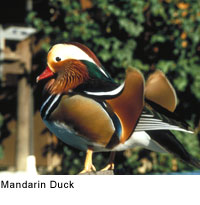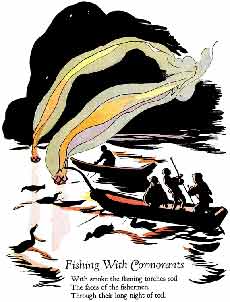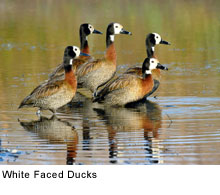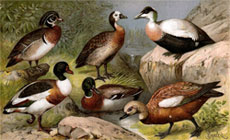|

 Features: The males (drakes) of northern species often have showy plumage, but Features: The males (drakes) of northern species often have showy plumage, but
this is moulted in summer to give a more female-like appearance, the "eclipse" plumage. Many species of ducks are temporarily flightless while moulting; they
seek out protected habitat with good food
supplies during this period. This moult typically precedes migration.
Stylish Birds: Ducks are also kept for their ornamental value. Breeds have been developed with crests and tufts or striking plumage. Shows are held in which these birds can
be displayed.
Bird Confusion: Ducks are sometimes confused with several types of unrelated water birds with similar forms, such as loons or divers, grebes, gallinules, and coots.

 Feeding: Most ducks have a wide flat beak adapted for dredging. They exploit a variety of food sources such as grasses, grains and aquatic plants, fish, and insects. Some (the diving ducks) forage deep underwater; the others (the dabbling ducks) feed from the surface of water or on land. Feeding: Most ducks have a wide flat beak adapted for dredging. They exploit a variety of food sources such as grasses, grains and aquatic plants, fish, and insects. Some (the diving ducks) forage deep underwater; the others (the dabbling ducks) feed from the surface of water or on land.
To be able to submerge easier, the diving ducks are heavier for size than dabbling ducks, and therefore have more difficulty taking off to fly. A few specialized species (the goosander and the mergansers) are adapted to catch large fish.
Migration: Some duck species, mainly those breeding in the temperate and arctic Northern Hemisphere, are migratory, but others are not. Some, particularly in Australia where rainfall is patchy and erratic, are nomadic, seeking out the temporary lakes and pools that form after localised heavy rain.

 Duck Hunt: In many areas, wild ducks of various species (including ducks farmed and released into the wild) are hunted for food or sport, by shooting, or formerly Duck Hunt: In many areas, wild ducks of various species (including ducks farmed and released into the wild) are hunted for food or sport, by shooting, or formerly
by decoys. From this came the expression "a sitting duck" to mean "an easy target".
Economic Uses: Ducks have many economic uses, being farmed for their meat, eggs, feathers and down feathers. They are also kept and bred by aviculturists and often displayed in zoos. Most domestic ducks were bred from
the wild Mallard, Anas platyrhynchos, but many breeds have become much larger than their wild ancestor, with a "hull length" (from base of neck to base of tail) of 30 cm
(12 inches) or more and routinely able to swallow an adult British Common Frog, Rana temporaria, whole.
Farming Ducks: Ducks have been farmed for hundreds of years. They are not as popular as the chicken because the latter has much more white, lean meat and are easier to keep confined. Nevertheless, the duck is a popular and well known farm bird.
 Ducks are farmed for their meat, eggs and down. Their eggs are bluey green to white depending on the breed. Ducks can be kept free range, in cages, or batteried. To be healthy, ducks should be allowed access to water, though battery ducks are often denied this. They should be fed a grain and insect diet. Ducks are farmed for their meat, eggs and down. Their eggs are bluey green to white depending on the breed. Ducks can be kept free range, in cages, or batteried. To be healthy, ducks should be allowed access to water, though battery ducks are often denied this. They should be fed a grain and insect diet.
Its a popular misconception that ducks should be fed bread as it offers them no nutritional value and can be deadly when fed to developing ducklings.
Trivia:
In a wildlife pond, the bottom over most of the area should be too deep for dabbling wild ducks to reach the bottom, to protect bottom-living life from being constantly disturbed and eaten by ducks dredging.
The sound made by some female ducks is called a "quack"; a common (and false) urban legend is that quacks do not produce an echo.
Ducks and humor: In 2002, psychologist Richard Wiseman and colleagues at the University of Hertfordshire (UK) finished a year-long LaughLab experiment, concluding that, of the animals in the world, the duck is the type that attracts most humor and silliness; he said "If you're going to tell a joke involving an animal, make it a duck."
The word "duck" may have become an inherently funny word in many languages because ducks are seen as a silly animal, and their odd appearance compared to other birds.

All text is available under the terms
of the GNU Free Documentation License
|